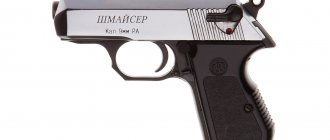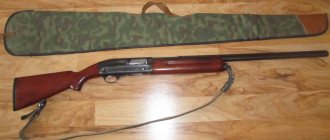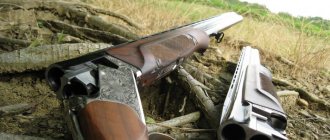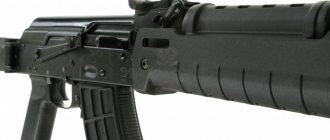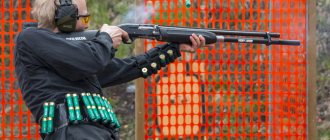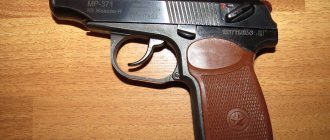- November 17, 2018
- Weapons and ammunition
- Michael
Probably every one of our compatriots who is even slightly interested in weapons or hunting has heard about the Saiga-12 gun. Reviews from hunters about it are mostly positive, which is the best recommendation. But still, learning about the important advantages and disadvantages and the most popular modifications will be useful for every weapon connoisseur.
History of creation
The Saiga hunting carbine was first manufactured back in 1974. This happened at the request of the workers of the Kazakh SSR. The fact is that in the west and south herds of animals - saiga - have proliferated. Herds of tens and hundreds of heads, moving across deserts and steppes, rejoiced at the opportunity to eat to their heart's content on the collective farm fields. But the local workers were not at all happy with this. Conventional smooth-bore weapons turned out to be insufficiently effective - sensitive animals did not allow them to get within shooting range. But it was impossible to purchase a sniper rifle, carbine or machine gun, which are in service with the army.
That is why Saiga-5.6 was manufactured. It used a very unconventional 5.6 x 39 mm cartridge and proved to be very effective at shooting ungulate pests.
Subsequently, a carbine was also released for a more common cartridge - 7.62 x 39, which at one time was the most common in our country, because it was the one used by the Degtyarev machine gun, the Kalashnikov assault rifle and the Simonov carbine. Well, later, having assessed the needs of the market, IzhMash engineers produced several versions of smooth-bore weapons. At first it was Saiga-12. Reviews from hunters who used it for shooting were mostly positive. Therefore, soon guns of 16, 20 and even 410 caliber, which is quite rare in our country, also appeared.
The first carbines were made on the basis of the proven and beloved Kalashnikov assault rifle. Of course, in appearance they also strongly resembled him. Subsequent guns (especially most smoothbore ones) were already very different in appearance, although the layout and many technical solutions were preserved.
Saiga-12. SVD tactics 3-4
Tuning from the Legion company, located in Izhevsk, is one of the most popular and advanced. The appearance of the carbine is similar to the Tiger; it also has a 580 mm long barrel and a slot-type flash suppressor. The barrel has oblong holes that help to effectively cool it when firing. The magazine holds 5 rounds.
The orthopedic butt is similar in shape to the butt of the SVD rifle; there is a rubber shock absorber on its rear side.
The model has ballistic characteristics similar to Saiga-12, but has a catchy appearance, which is liked by many hunters and security company employees.
Purpose
The scope of application of Saiga-12 is quite extensive. This is not surprising: a reliable, simple and unpretentious weapon is the dream of many shooters.
First of all, it is used for hunting. And it gets mostly very positive reviews from hunters. Depending on the caliber, it is used in hunting, the purpose of which is to kill various animals. We'll talk about this a little later.
Saiga is no less popular among ordinary shooting enthusiasts. Good ergonomics (especially if the weapon is subjected to tuning), reliability and, most importantly, appearance, which makes some models look like the legendary Kalashnikov assault rifle, attract many shooters. Of course, 12 gauge is pretty serious; Such weapons are best suited for adult, strong men. But there is also Saiga-410, which will be a good choice for women and teenagers, allowing them to instill in them a love of weapons and avoid unpleasant consequences of use, such as bruises on the shoulder.
Finally, the characteristics of the 12-gauge Saiga were carefully studied by the military of different countries, who subsequently adopted it for service. For example, it is used by law enforcement agencies and intelligence services of countries such as Russia, Ukraine, Indonesia, the USA, and Kyrgyzstan. True, in 2014, as a result of the introduction of sanctions, the import of these guns to the United States from Russia was prohibited.
Quite often, this formidable weapon is purchased to protect home and property. Indeed, at a short distance, a shot from a bullet, buckshot or even shot from a 12-gauge Saiga causes the most terrible damage, which neither a Kalashnikov assault rifle nor a Makarov pistol can compare with.
"Saiga-12s"
The Saiga-12s gun became a little more interesting. Reviews from hunters and ordinary shooters about this modification confirm its effectiveness.
In general, this modification is very similar to the one mentioned above. The barrel length is also 580 or 680 mm. The sights are exactly the same.
The main difference is the folding plastic stock. When folded, the weapon becomes much more compact - 820 mm versus 1160 mm. Of course, this makes the process of transportation and storage much easier. At the same time, there is no locking mechanism that would not allow shooting with the butt folded, like the Saiga-12k (more on that a little later). Even in this condition, the weapon fully complies with all existing legal standards.
There is also a pistol grip, which allows you to fire with relative comfort with the butt folded, for example, if you have to operate in confined spaces.
According to most owners, this modification is more successful than the classic Saiga-12, since it retains all its advantages and at the same time is more compact when folded.
Ammunition for Saiga-410
The carbine uses 10.25 mm cartridges, which are considered the smallest for shotguns. Classic, low-effective cartridges have a case length of 70 mm, more powerful ones - 76 mm and already allow you to hunt medium-sized animals using bullets rather than buckshot/shot. When using 76mm Magnum cartridges, Saiga is able to outperform many competitors. This weapon is also beloved as a weapon of self-defense and for amateur shooting.
Magnum cartridges for Saiga 410
"Saiga-12k"
In all external parameters, this gun resembles those mentioned above. But at the same time it is much more compact due to the shortened barrel - its length is only 430 mm. This has both pros and cons. Compactness, lighter weight and a better located center of gravity are important advantages, thanks to which the Saiga-12k receives rave reviews from hunters and shooters. The downside is that the short barrel further reduces the firing distance.
In addition, in order for the weapon to comply with modern legislation, the developers were forced to install a special locking mechanism that does not allow firing with the butt folded. The shooter must first fold back the butt and only after that he gets the opportunity to shoot.
However, there is also an export version, which has the same dimensions as the Saiga-12k, but lacks such a mechanism. It is intended for use in countries with laxer gun laws than Russia.
Partial disassembly of Saiga rifles
Partial disassembly of all carbines, including Saiga 12K 030, 308 isp. 44 and 20K, carried out according to the same scheme. First, remove the optical sight if it is attached to the bracket. To do this, turn the bracket handle against the movement of the clock hand, and then pull the sight back so that it separates. Then you need to get rid of the receiver cover. This must be done by pressing the protrusion of the return mechanism. Once the cover is removed, the return mechanism itself can be removed. All carbines are disassembled using this principle, be it Saiga 12, Saiga 410, Saiga 20K, 308, Spanish. 44 or other modification. Next, they begin to separate the frame: it is pulled back as far as it will go and, moving upward, it is removed from the guide box along with the shutter. The shutter is removed from the frame channel. Separate the gas tube by pressing its pins on the feather. In case of emergency, remove the forend, which is secured with screws. Reassembling the weapon should be done in reverse order. To avoid any difficulties, it is recommended to take a photo after each operation performed.
Important benefits
Now let’s try to figure out why this weapon has become so popular all over the world. To do this, we will consider all the pros and cons inherent in the Saiga-12 gun. Let's start with the advantages.
Of course, the main one is reliability. After all, the weapon was developed on the basis of the Kalashnikov assault rifle, famous for its “indestructibility.” A similar arrangement allows the Saiga to serve well for a long time, even if its care leaves much to be desired.
For a long time, guns could also boast of high quality workmanship. Unfortunately, in the last two decades, such a purchase has become more of a lottery - one buyer can be very lucky, while another will receive a weapon that needs additional work from knowledgeable people.
Another important plus is interchangeable magazines. Still, replacing an empty magazine with a full one can be much faster than inserting several new cartridges into the under-barrel magazine of other semi-automatic devices like the MP-153 or MTs-21-12.
Existing disadvantages
Alas, any weapon that has its advantages cannot do without its disadvantages. When describing Saiga-12, it is important to talk about its shortcomings.
One of the main ones is the short distance of a confident fight. Which is not surprising - even the longest modifications have a barrel length of only 680 millimeters. For a hunting weapon this is quite a bit. For comparison, the famous TOZ-34 can boast a barrel length of 711 mm.
Another drawback is the short sighting line. After all, the rear sight and front sight are located directly above the gas outlet tube. This does not allow you to confidently aim at long distances. However, experienced shooters who really love weapons can easily solve this problem - we’ll talk about this a little later.
Saiga-12
Saiga-12k isp. 030 is a Saiga 12C Exp-01, equipped with a firing lock without an unfolded stock in accordance with Russian legislation. Designed for security and similar applications, the carbine is not very suitable for hunting, being compact, but not having sufficient shooting accuracy.
The disadvantage is compensated by a variety of tuning, which includes a variety of sighting equipment.
This modification is the most powerful self-defense weapon in Russia, which can be purchased with a hunting license. Hunting at distances up to 40 meters is not difficult; for longer distances, a choke attachment is used, which increases accuracy to a level of more than 40%.
Is it suitable for hunting?
This is not the first year that there have been serious debates between hunters: is Saiga-12 suitable for hunting? The question is really difficult. It should be looked into in more detail.
The main argument from opponents of using Saiga for hunting is the sighting device, which is not suitable for shooting offhand. Indeed, a standard rear sight and front sight are great if you need to shoot at a stationary or slow-moving target. But shooting down a flying duck or a rapidly running hare is much more difficult.
But still, experienced shooters with good marksmanship use these weapons very successfully when hunting, always returning with rich trophies. Namely, practice, as we know, is the most reliable criterion of truth.
And the ability to fire 5-8 shots without reloading, and then change the magazine in a second is a very pleasant prospect, especially if the target of the hunt is a wild boar, bear or elk.
So, if you are looking for a weapon that will allow you not only to successfully hunt, but also to protect your home, the Saiga-12 will be a really good choice.
Tuning options
Many owners also highlight the extensive opportunities for tuning and various weapon improvements. As you can see in the Saiga-12 photo attached to the article, you can install a sight - optical or collimator, solving the aiming problem. Also, some people purchase an additional front sight, the same as on an AK, increasing the aiming line.
Replacing the stock and fore-end is another way to significantly change the appearance of a weapon, making it more comfortable to work with.
Which store to choose
In general, in our country three types of magazines for Saiga-12 are produced. They have a capacity of 2, 5 and 8 rounds. And the choice here is not always obvious.
On the one hand, being able to fire 8 shots in a row, destroying everything in your path, is very pleasant. But this store is quite long, and its cost is quite high. On the other hand, by purchasing a 2-round magazine, the shooter does not use the full firepower of the weapon. But the magazine practically does not stick out from the Saiga, which means it will not cling to bushes, branches, clothes or any other objects, causing unnecessary problems.
Each hunter must decide for himself which option to choose based on his own needs and preferences.
In general, there are magazines of much larger capacity - including drum ones, which can hold up to 20 rounds at once. Alas, in our country, weapons legislation limits the maximum magazine capacity to eight cartridges. However, it is only prohibited to use magazines with a larger capacity, but storing them at home or carrying them with you is not prohibited at all.
So, having gone through all the bureaucratic obstacles and all kinds of dispensaries, the mere presence of which would compromise a decent person, and having overcome the discontent of your loved ones, you are ready to buy the coveted gun! This means that you inevitably face the problem of choosing your first weapon. The article was “chopped” from information from several sites at the time (two years ago) when I decided to buy a gun. So my apologies for copying without providing sources of information (those who are interested can find it in search engines). In any case, this article is not an advertisement but a reflection of my own opinion, and this information also helped me a lot when choosing a weapon. GO:
WHY DO YOU NEED A WEAPON, or CHOICE OF CALIBER? There can be three purposes for which a barrel is purchased: 1) for self-defense; 2) for entertainment (so-called plinking) and family recreation; 3) for hunting. Let's immediately leave the last point outside the scope of discussion - for hunting, a 12-gauge shotgun with a long barrel and a fixed wooden butt is preferable. Let’s make a reservation right away - the most acceptable and convenient weapon for the average person to use, transport and store for mass sports, recreational shooting and self-defense is certainly a compact small-caliber short-barreled weapon - i.e. pistols and revolvers, which are not allowed for purchase and storage at home for Russians. However, at the same time, laws allow Russian citizens to purchase and keep at home “long-barreled weapons” - powerful semi-automatic large-caliber shotguns and rifles. Therefore, the first practical conclusion is that if we are not allowed a gun for the home, then the home gun should be as compact as possible! With the shortest possible barrel! Have a butt! To be self-loading - semi-automatic! From this point of view, the compact semi-automatic "Saiga", made on the basis of the legendary "Kalashnikov", is interesting to us, weapon lovers, as the first smooth-bore carbine in the "military" style in our country, repeating the appearance and design of automatic combat weapons. Tempo shooting from such a carbine is fun and trains self-defense skills. Saiga 20 is rightfully considered the most optimal in terms of the ratio of weight, power and convenience, and the most advanced design, but some, mainly third-party factors make Saiga 12 more attractive. Thus, twelve-gauge supplies are the most common in relation to supplies of other “smooth” calibers, both in terms of availability and assortment, so the choice of shot, buckshot, bullet, as well as the manufacturer (i.e. price and quality) for cartridges of this caliber is the biggest. Naturally, in terms of power, Saiga 12 is the maximum that can be squeezed out of a Saiga, although you have to pay for it with additional weight and stronger recoil. In terms of design and reliability, Saiga 12 is similar to the “twenty”. Despite the disadvantages described above, over time you get used to the strength of the gun, and also to the weight, and only the advantages remain: the maximum possible power (and you want to get the most out of the “machine”) and a large selection of supplies. CHOOSING BARREL LENGTH: “SAIGA-S” OR “SAIGA-K”? For self-defense and recreational shooting, the shortest carbine, the Saiga-K, with a folding butt, is most suitable. This weapon is compact, balanced in design and convenient for rapid shooting at practical distances (5-15 m, maximum 20-30 m). After all, the shorter the shooting distance, the more convenient the short-barreled weapon. Of course, you can shoot at a quick pace with a long hunting rifle with an 800mm barrel, but this is, to put it mildly, inconvenient. However, some choose the longer-barreled Saiga-S, as it allows you to shoot with the butt folded. The need for such shooting even for the purposes of self-defense is highly doubtful. After all, a carbine is not a pistol; it is not carried in a pocket or holster. Current legislation and rules for storing weapons should also be taken into account. In case of danger, you will most likely have enough time to assess the impending threat, have time to unfold the stock and cock the bolt. With a little practice, all this will take no more than a few seconds. The arguments in favor of shooting with the butt folded while traveling in a car are also not very valid. All the same, you do not have the right to keep a carbine without a case with a folded butt on the front seat while driving, so it is unlikely that you will be able to instantly grab it and open fire. If you have at least 5 seconds at your disposal, you will have time to fold back the stock, insert the magazine, cock the bolt and shoot. Shooting from the hip is categorically not recommended and does not provide significant time savings, since it requires special skills and does not provide a reliable hit and clear control of the weapon. Some people buy a long gun for increased accuracy. But, from experience (and from theory too), the length of a smooth barrel does not provide a reliable increase in the accuracy and accuracy of shooting a bullet at distances of 25-40 m. And a short carbine is much more compact, convenient and “more agile” in confined spaces (corridor, house, cottage, car). Its only drawback is the slightly increased volume of the shot. CHOZZLE: CHOCK OR CYLINDER? Short Saiga-K carbines were manufactured mainly according to the hunting tradition with a standard choke of 0.9, which makes it impossible to shoot with “caliber” bullets, i.e. close in diameter to the bore: they can easily get stuck at the exit. Now Izhmash has begun producing Saiga 20K and Saiga 12K with interchangeable nozzles, including a cylinder - a nozzle without a narrowing at the end. But there are cases of misalignment of the nozzles with the barrel (factory defects), which leads to inaccurate hits even at a short distance. In addition, a carbine with replaceable attachments is more expensive. On the other hand, the 0.9 muzzle constriction does not interfere at all with shooting bullets in a plastic container. In this case, the bullet is obviously narrower than the barrel and easily passes through the narrowing. We recommend using these container bullets and container shot, as this will not damage or lead the barrel. In addition, bullets are mainly used for plinking (recreational shooting at bottles), while small shot or buckshot is used for self-defense and rapid shooting training. So having a choke on a short carbine isn't that bad.
Now I will try to describe the gun constructively in order to show some important nuances, since the general quality of the products that are offered in the store is such that you need to carefully choose a normal gun, and not take the first one you bring. In general, all of the above applies to Saiga 20 (exactly as well as vice versa), since the 12 and 20 caliber models are practically similar in design (with the exception of some details).
After you have decided which model you are taking, find a way to familiarize yourself with the product passport in advance and in detail.
Trunk. The channel is chrome plated. It can have a constant choke (1 mm choke), or be cylindrical and have a set of nozzles (1 mm choke, 0.5 mm choke and cylinder). Constant choke (Choke):
In the version with nozzles, the alignment of the latter with the barrel is not guaranteed (in fact, rather the opposite). The difference between these two options is that a barrel with a choke is more optimal for shooting with shot and when shooting with buckshot or a bullet, the result will be slightly worse than when shooting from a cylinder or a cylinder, respectively. It is also categorically not recommended to shoot caliber bullets from a choke (although you still need to look for them on sale). Interchangeable attachments, in theory, allow you to optimize the gun for a specific type of supply: shot, bullet or buckshot. But in reality, the thread for the attachments on the barrel is quite small and short, so screwing something else onto the barrel, especially a long one, is unlikely to be used.
When choosing: clean from oil until dry and very carefully inspect the entire channel in the light for scratches, chips, cracks, for which you should look at the walls along the entire channel, while rotating the gun. Next, check the roundness and straightness of the barrel: to do this, you need to insert an unprimed cartridge case (ask in the store, but it’s better to buy it first because the store may answer “sorry, no”) into the chamber and look through the barrel at the light: by moving the gun, rings will appear. The rings should be smooth and round and centric to each other. Inspect the choke (if there is one) from the chamber: the rim should be uniform around the entire circumference. Inspect the chamber: for convenience, fold the butt (remembering to first raise the safety lever), the rim of the transition of the chamber into the barrel should also be uniform. The muzzle of the barrel must be smooth, without traces of impacts, etc. Another important detail: according to the passport, the shot dispersion (5) should not be less than 40%, and the passport indicates the obtained value specifically for each barrel, so it is advisable to take a gun with the highest possible number (for example: the first gun I took was 42%, the second - 57%). Spend as much time as possible inspecting the barrel - this is one of the most important parts.
Gas exhaust system. It is a chamber into which powder gases are discharged through four transverse holes in the barrel. This chamber contains a piston, which, unlike the “male”, is a separate part from the bolt frame, and can move inside the chamber without going beyond its limits, being limited by the restrictive wall on one side and the gas regulator on the other. The “piston” of the bolt frame is not actually such, but serves only as a pusher of the frame when firing and a pusher of the gas piston during the return stroke. This mechanical decoupling makes it possible to protect the shooter in case of excessive pressure in the chamber, since the bolt frame moves back due to inertia, and not due to the direct pressure of gases on it. Moreover, to relieve excess pressure, a hole was made in the side wall of the chamber leading under the forend, where the gases that escaped under the piston are diverted. The gas regulator allows you to change the volume of gases entering the chamber per unit of time and has two fixed positions: “1” for high-power cartridges (magnum) and “2” for normal-power cartridges (in the figure, the regulator is in position “2”). The design of the regulator does not prevent the passage of gases into the chamber, so they cannot “turn off” the automation. The gas outlet unit also serves for attaching a bolt (M5 standard) to the forend and front swivel, as well as a place for attaching the front sight (M4 standard)
Gas system 1-barrel, 2-chamber, 3-gas regulator, 4-gas piston, 5-bolt follower, 6-guide tube
When choosing: you can disassemble (first remove the bolt carrier), unscrewing the regulator, inspect the regulator itself (thread) and the piston. You can remove the piston with a cleaning rod, carefully pushing it out from the breech side of the tube (provided that the bolt frame is removed), and inspect “through and through” the chamber and the guide tube for rust and quality of processing.
Gate. The bolt carrier with the bolt is structurally similar to similar parts of the AK and has no special differences. When choosing: Pay special attention to the bolt lugs; there should be no cracks or “strange” chips. You should also carefully inspect the lugs of the receiver: there should also be no cracks or chips. The frame with the shutter should move freely to the end and, when released, return completely to the stop.
Butt. Short automatic. There is a metal “shock absorber” at the end, which hurts a little, especially if the butt is not pressed tightly against the shoulder. Of course, you can get used to it, but it’s better to put on tires. To be fair, the hardware doesn’t “get” that much. When choosing: neither in the folded nor in the unfolded state (especially) it should not dangle, it should be fastened and unfastened easily.
Shop. It is quite easy to load if the edges of the cartridge case bases are pressed into the cartridge case, otherwise the flanges of the next inserted cartridges will cling to them. The magazine is attached with some difficulty, since before hooking its protrusion to the edge of the receiver, it should be pressed down somewhat and the protruding cartridge should be recessed into the depths of the magazine, but with some practice this inconvenience disappears. When choosing: The magazine hooked to the receiver should snap into place quite easily. The magazine latch should move freely, without any assistance, and its fastening should be straight.
For variants with a folding stock: Locking. Made to comply with gun laws. But even for an absolutely law-abiding Saiga owner, this miracle of engineering can create certain problems, and here’s why. First, let's look at how this mechanism works. The mechanism is simple, like everything ingenious, and consists of a tongue (limiter) driven back and forth by a lever mounted on the safety axis. The tip of this tongue has the ability to extend into the hinge joint of the butt, into which it rests if the butt is not unfolded, preventing the safety from turning further, or it freely fits into a slot in the loop if the buttstock is completely unfolded. This design ensures not only the impossibility of removing a weapon from the safety lock with the buttstock folded or not fully unfolded, but also prevents the butt from folding on a weapon that has already been removed from the safety lock. The design is, of course, original. But everything would be fun if it weren't so sad. The fact is that the safety is driven by a lever that is long enough and tight enough, so if you forget to unfold the butt, you can easily roll the safety (due to the greater moment of force). The store immediately warns that if the fuse is broken, the Saiga will not be taken back. It’s the same with the butt: to avoid damage, always remember the safety. Scheme (simplified) of the locking mechanism. 1-butt, 2-barreled box, 3-limiter, 4-translator sector (safety), 5-translator (safety lever): the butt is folded, the limiter rests on the butt loop, preventing the translator sector from moving backwards, and the translator itself moving down.
the butt is unfolded, the limiter freely fits into the cutout of the butt loop, without interfering with the movement of the translator's sector, but locking the butt.
Affiliation. Like the butt, Saiga’s accessory was inherited from a machine gun (except for the brush, of course), and the ramrod, apparently, from a machine gun. You won’t be able to clean the Saiga like a machine gun with a cleaning rod (by properly assembling it into a pencil case): the lid of the pencil case won’t fit on the barrel, and the hole in the lid is such that the cleaning rod won’t fit into it (???). Therefore, it is better not to use the included cleaning rod at all, since you can scratch the bore (by rubbing) or the muzzle (by the wall of the cleaning rod). It is also impossible to exclude the destruction of the brush in the bore, which can also lead to damage to the chrome coating. Buy or make a wooden one. A screwdriver and a drift are used as in a machine.
The described checks are a necessary, but not sufficient condition for the proper quality of Saiga; a sufficient condition is shooting and its results.
So, you bought Saiga... Now you need to test it in action. First of all, you need to set the gas regulator to position “1” (magnum), since the recoil force of the bolt frame at this position of the regulator will be the smallest, which will lead to minimal consumption of the gun’s life (in other words, the box will not gouge so much). In theory, the automation should work flawlessly even with regular-power cartridges, although it is not required. If it is still cold (winter), when the power of the shot drops, then stable operation of the automatic (at “1”) will be a very good indicator for your gun. Shooting. It is advisable to shoot from a machine gun, but you can also get by by shooting from your knees or from another more or less stable position. You should not rush to watch every shot, so as not to throw off the gun and thereby introduce an additional error into the result. If from 30 meters you managed to fit a bullet into a circle the size of a CD, this is a completely satisfactory fight. It is not at all necessary that all the fired bullets lie in a “heap”; if 4-5 bullets lie in a heap, this can be considered a result, the main thing is that the “heap” is clearly defined. If this does not happen, perhaps you were unlucky with the ammunition and then you need to shoot again. If the “pile” moves away from the center to the side, it’s not a big deal; you can adjust the rear sight later, or better yet, put a high front sight and adjust it (it’s better not to touch the rear sight at all). As for the number of rounds needed to understand how your gun works and where it hits, then everything will depend on the result: if with ten rounds you got a normal “pile” without a single delay, why burn more cartridges? After shooting, collect all your cartridges and inspect them: there should be no torn walls. If some of the cartridges are torn, then it is important that their breaks do not coincide with each other. The fact is that the sleeves themselves may be of poor quality, and in the cold the likelihood of rupture increases. The presence of equally torn cartridges will most likely indicate a low-quality chamber. In this case, shoot some more cartridges (preferably from a different manufacturer); if the cartridges again tear equally, then it is better to take the gun back to the store (taking the cartridges with you as evidence). You should take the gun back, especially in the case when the cartridges rupture at the bottom (this is a defect according to the passport).
WHAT YOU NEED TO BUY AT THE SAME TIME WITH THE BARREL 1. STORES. In addition to the standard kit, take at least one increased-capacity magazine: for Saiga 410 - 10-round, for Saiga-20 and Saiga-12 - 8-round. You should ALWAYS take a magnum magazine, i.e. 76 mm long. This is a universal size, suitable for short and long cartridges. True, some short shot cartridges with a star twist of 70 mm or less, when fed from the magazine into the chamber, stand up straight and are jammed by the bolt. In these special cases, a 70mm magazine is a must. And it’s better not to mess with such cartridges at all. I strongly do not recommend 10-round magazines for 20 and 12 gauges - they are clunky, inconvenient monsters, often from “leftist” small manufacturers, terrible in design and unreliable. Perhaps, over time, something more decent will appear on the market, but for now... But the “native” Izhmashev 8-chargers have proven themselves very well. ATTENTION: all professionals strongly advise loading one less round into the magazine than its capacity allows. Practice shows that this significantly reduces the risk of jamming. And one more thing: do not insert cartridges of different types and from different manufacturers into the magazine! 2. CLEANING KIT AND OIL. Domestic sets with a 3-section screw-in cleaning rod are preferred. They are cheaper, and in addition, you can later buy separate brass brushes, etc. For 12 gauge, we recommend purchasing a set of a smaller diameter - say, for 16 or 20 gauge: then the brushes will pass through the barrel better when cleaning and you can wrap a cloth around them to wipe the barrel. Aerosols are better than oils - they are more expensive, but more convenient. For example, one can of German aerosol oil is enough for me for two years of regular shooting. Alkaline mixtures are not particularly necessary: with a smooth barrel, everything is easily cleaned with two passes with oil, after which the barrel is wiped dry, leaving a thin layer of oil on the bolt and its guides. You can buy VELV oil or (if finances allow) NATO CLP Break-Free. By the way, I note: one of the features of the Saiga 12 and 20 gauge is the presence of a gas piston in the form of a separate part, exposed to hot powder gases. It becomes covered with soot when shooting and has a tendency to corrosion if it is not cleaned in a timely manner. 3. A CASE needs to be as short as possible, rectangular, preferably black, so as not to attract unnecessary attention to your weapon. A camouflage-colored case clearly indicates the presence of a weapon. Why waste time communicating with a policeman, even if it does not threaten you with anything, as a law-abiding owner of a weapon transporting it in accordance with the “Weapons Law”?! And why tease potential aggressors?! Some people carry a carbine in a guitar or violin case. The most disgusting cynicism in relation to the fine arts, but practical. 4. CARTRIDGES. Immediately take more of them and of good quality. Previously, it was recommended to use only Taiga cartridges - do not consider it an advertisement, but now it has practically left the market and, based on our experience, it is recommended for now to shoot Feter 12-gauge shot cartridges. This company also promised to release 20-caliber cartridges, and perhaps they will also be quite reliable for a semi-automatic and have an acceptable price/quality ratio. Take 75-100 pieces at once. You will need shot cartridges to test the operation of the automation, and bullet cartridges to test the accuracy of the sight. If the cartridge is of low quality, during test shooting you will not understand the cause of the problem: whether the weapon itself is to blame or a bad cartridge. Additionally, once you purchase the barrel, you will no longer be able to use your gun permit stub to purchase ammunition—so it's best to do so right away, otherwise you'll have to wait to get your ammo until you get your permanent gun permit. 5. BELT Buy a special tactical one so that you can carry the weapon not on your shoulder behind your back, but on the side under your right hand with the barrel down. Don't buy nice, hard leather belts - they're too hard for shooting.


